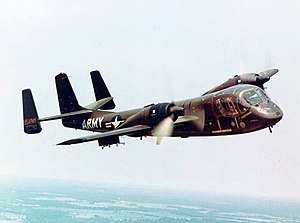OV-1 Mohawk
| OV-1 Mohawk | |
|---|---|
 |
|
| US Army OV-1 Mohawk | |
| Role | light attack and observation aircraft |
| Manufacturer | Grumman |
| First flight | 14 April 1959 |
| Introduction | October 1959 |
| Retired | September 1996 (USA) |
| Status | Retired |
| Primary users |
United States Army (historical) Argentine Army Aviation (historical) |
| Produced | 1959-1970 |
| Number built | 380 |
The Grumman OV-1 Mohawk was an armed military observation and attack aircraft, designed for battlefield surveillance and light strike capabilities. It was a twin turboprop configuration, and carried two crew members in side-by-side seating. The Mohawk was intended to operate from short, unimproved runways in support of United States Army maneuver forces.
The Mohawk began as a joint Army-Marine program through the then-Navy Bureau of Aeronautics (BuAer), for an observation/attack plane that would outperform the Cessna L-19 Bird Dog. In June 1956, the Army issued Type Specification TS145, which called for the development and procurement of a two-seat, twin turboprop aircraft designed to operate from small, unimproved fields under all weather conditions. It would be faster, with greater firepower, and heavier armour than the Bird Dog, which had proved vulnerable during the Korean War. The Mohawk's mission would include observation, artillery spotting, air control, emergency resupply, naval target spotting, liaison, and radiological monitoring. The Navy specified that the aircraft must be capable of operating from small "jeep" escort class carriers (CVEs). The DoD selected Grumman Aircraft Corporation's G-134 design as the winner of the competition in 1957. Marine requirements contributed an unusual feature to the design. As originally proposed, the OF-1 could be fitted with water skis that would allow the aircraft to land at sea and taxi to island beaches at 20 kts. Since the Marines were authorized to operate fixed-wing aircraft in the close air support (CAS) role, the mockup also featured underwing pylons for rockets, bombs, and other stores.
The Air Force did not like the armament capability of the Mohawk and tried to get it removed. The Marines did not want the sophisticated sensors the Army wanted, so when their Navy sponsors opted to buy a fleet oil tanker, they dropped from the program. The Army continued with armed Mohawks and developed cargo pods that could be dropped from underwing hard points to resupply troops in emergencies.
The radar imaging capability of the Mohawk was to prove a significant advance in both peace and war. The Side-Looking Airborne Radar (SLAR) could look through foliage and map terrain, presenting the observer with a film image of the earth below only minutes after the area was scanned. In military operations, the image was split in two parts, one showing fixed terrain features, the other spotting moving targets.
...
Wikipedia
